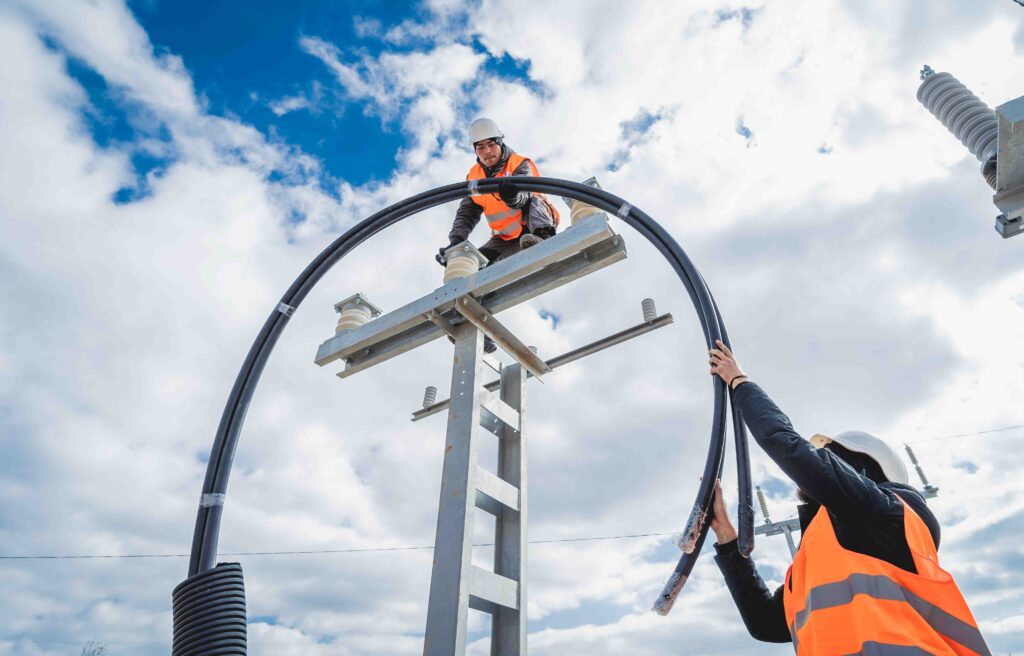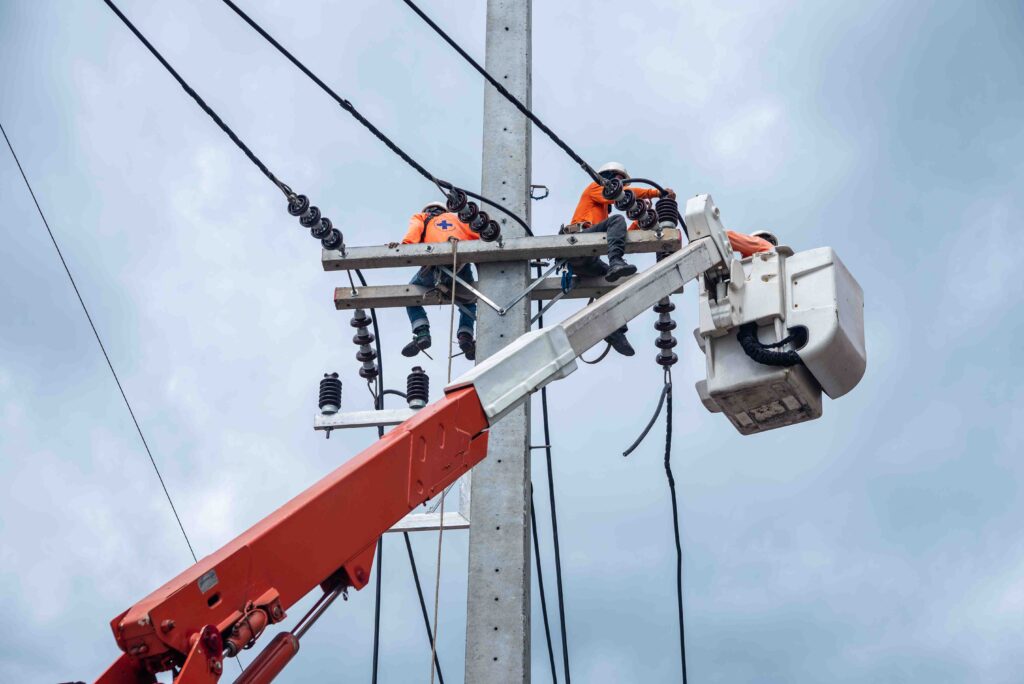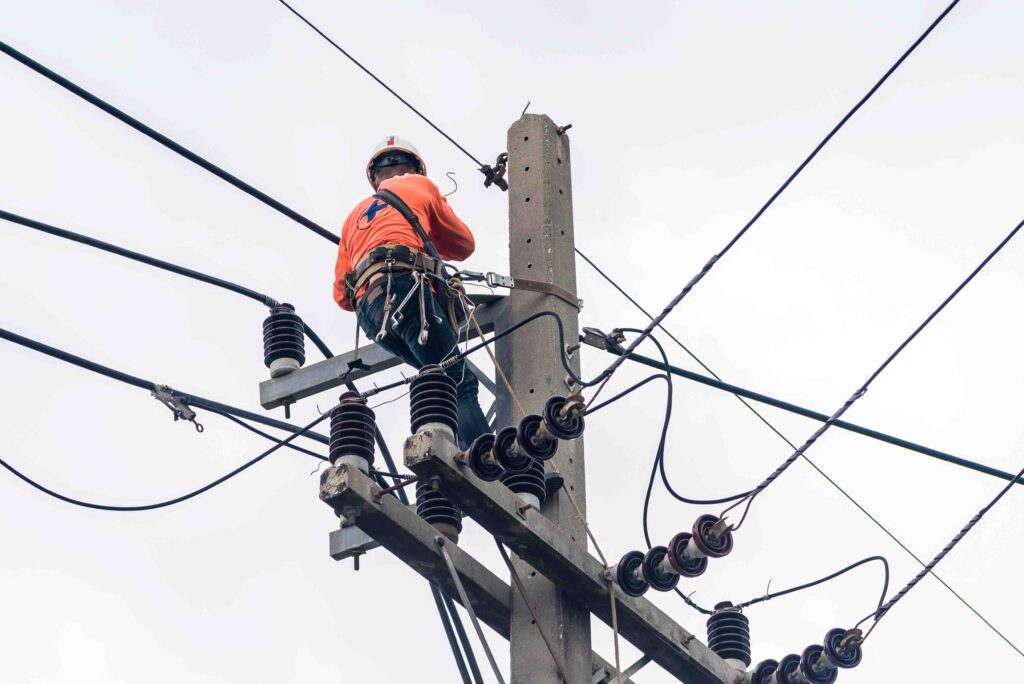An Aerial Lineman installs and maintains electrical power and telecommunications lines. They work at height, often on poles and towers, to ensure network integrity.
An essential figure in the utility sector, the Aerial Lineman bridges the gap between communities and the vital services of electricity and communications. With a steadfast commitment to safety and efficiency, these skilled professionals spend much of their workday elevated above the ground, braving heights and the elements.
Tasked with the construction, maintenance, and repair of overhead network lines, these linemen ensure that power outages are swiftly addressed and service is reliably restored. Their role demands technical know-how, physical stamina, and an unwavering attention to safety protocols. As technology advances, Aerial Linemen must also adapt, embracing new methods and equipment to effectively manage the evolving landscape of power and telecommunication infrastructures.
Job Description
Aerial linemen play a crucial role in keeping the lights on and communication lines active. These specialized technicians install and maintain the infrastructure that powers cities and connects individuals. Their work demands expertise, safety knowledge, and physical prowess, all of which come together to ensure our daily conveniences remain uninterrupted.
Installation Of Overhead Power And Telecommunication Lines
New developments and infrastructure projects constantly require the installation of new lines. Aerial linemen are responsible for:
- Setting utility poles and towers.
- Stringing and connecting wires and cables.
- Establishing essential electrical and data connections.
Maintenance And Repair Of Existing Lines
Existing lines need regular upkeep due to wear or damage. Tasks include:
- Inspecting and testing power lines and systems.
- Identifying problem areas and performing immediate repairs.
- Upgrading old infrastructure to ensure reliability.
Climbing To Access Elevated Areas
Aerial linemen must navigate heights safely and effectively. They:
- Use ladders and climbing gear to reach work areas.
- Adhere to strict safety protocols to prevent falls and accidents.
- Maintain balance and concentration at high elevations.
Working With Heavy Machinery And Equipment
This role involves handling various tools and machinery. Aerial linemen must:
- Operate bucket trucks, lifts, and power tools.
- Transport materials and equipment to job sites.
- Follow procedures to ensure the safety of themselves and others.

Skills Required For The Job
Embarking on a career as an Aerial Lineman demands a unique set of abilities. These pros work high above the ground, dealing with the lifelines of electricity that power our lives. Understanding the crucial skills is a must for those eager to climb both poles and career ladders. Let’s explore what it takes to excel in this electrifying role.
Physical Fitness And Agility
To succeed as an Aerial Lineman, robust health and maneuverability are non-negotiable. Picture scaling tall structures and handling hefty equipment, often under challenging weather conditions. A Lineman’s body must be a tower of strength and flexibility. Expect tasks that include:
- Lifting heavy objects
- Climbing poles and ladders
- Performing detailed tasks with your hands
Regular fitness training helps prepare for the physical demands of this dynamic role.
Comfort With Heights
Heights are an everyday encounter for an Aerial Lineman. Working aloft, sometimes several hundred feet up, calls for a calm and focused mind. If towering above the earth feels like home, this might be your calling. The ability to remain steady where others may falter separates the novice from the seasoned Lineman.
Electrical And Mechanical Knowledge
Understanding the intricacies of electrical systems forms the backbone of this profession. A Lineman must interpret technical diagrams and comprehend the workings of the electric grid. Essential knowledge includes:
| Electrical | Mechanical |
|---|---|
| Circuit theory | Tool proficiency |
| Code requirements | Equipment maintenance |
| Safety practices | Assembly/disassembly of structures |
An aptitude for learning complex concepts is crucial for mastering these domains.
Problem-solving Skills
An Aerial Lineman encounters unexpected challenges with regularity. Power outages, line damages, and technical glitches demand quick and effective resolutions. A nimble mind equipped to troubleshoot and apply logical solutions stands as a pillar of proficiency in this field. Every problem solved ensures safety and restores vital services, reflecting the Lineman’s pivotal role in society.
Preparing For An Aerial Lineman Career
An exciting journey lies ahead for future aerial linemen. Start with the right steps to achieve success. A career as an aerial lineman requires skill, dedication, and proper education. Follow these paths to build a strong foundation for your aerial lineman career.
Obtaining A High School Diploma Or Ged
Earning a High School diploma or a GED is the first step. It opens doors to further training. Many employers see this as a basic requirement. Focus on subjects like Math, Science, and English. These areas enhance your technical skills and communication.
Completing Vocational Training In Electrical And Mechanical Fields
After high school, consider vocational training. Courses in electricity and mechanics are vital. Vocational schools offer specialized training. This program gives practical experience. That experience is crucial for aerial lineman tasks. Topics covered may include:
- Electrical Theory and Safety Practices
- Power Line Systems and Maintenance
- Climbing Techniques
- Equipment Operation
Undertaking An Apprenticeship Program
An apprenticeship program is necessary. Real-world experience is gained here. Work alongside skilled linemen. Apply classroom knowledge. Expect to learn through on-the-job training. Common apprenticeship programs last 3 to 4 years. Apprentices must complete:
| Requirement | Details |
|---|---|
| Hours of On-the-Job Training | 6,000 to 8,000 hours |
| Classroom Instruction | 144 hours/year |
| Safety Training | Varies |
Graduates from apprenticeships earn a journeyman lineman status. They are ready for entry-level positions in the field.

Safety Measures
Ensuring the safety of aerial linemen is paramount due to the high-risk nature of their work. Constantly surrounded by the dangers of heights and high voltage, they must strictly follow established safety protocols. We’ll explore the critical safety measures that form a safety shield around these courageous workers.
Utilization Of Appropriate Safety Gear
The right safety gear is a lineman’s first line of defense. They must wear:
- Insulated gloves
- Flame-resistant clothing
- Safety glasses
- Hard hats
- Steel-toed boots
Regular Inspection And Maintenance Of Equipment
Equipment integrity is non-negotiable. Tools, vehicles, and safety gear require regular checks. A daily pre-job inspection identifies potential issues, ensuring tools and equipment are fit for use. This step minimizes the risk of accidents caused by equipment failure.
Strict Adherence To Osha Safety Guidelines
Adherence to Occupational Safety and Health Administration (OSHA) guidelines is critical. These regulations encompass:
- Proper training
- Work procedures
- Emergency protocols
Proximity Warning Devices And Alarms
Proximity warning devices create an additional layer of safety by alerting linemen to potential hazards. These include:
- Audible alarms
- Visual warnings
- Motion sensors
Challenges Faced By Aerial Linemen
Aerial linemen scale great heights to ensure our power grids remain operational. This career, vital to our everyday comfort, holds various challenges. Unique risks and job site issues make this work not just intricate but also hazardous. Here, we describe the trials that these skilled professionals confront daily.
Workplace Injuries And Fatalities
Aerial linemen encounter risks like electric shocks and falls from high structures. Safety gear and training can minimize these dangers, but they always lurk. The Bureau of Labor Statistics often lists this job as one of the most dangerous. These risks can lead to severe workplace injuries and, tragically, sometimes fatalities.
Weather-related Disruptions To Work
Work cannot halt due to bad weather. Linemen face rain, snow, and extreme temperatures. These conditions can increase the risk of accidents and slow down work. High winds might also cause complications. Linemen must be prepared for these weather challenges daily.
Unforeseen Obstacles On Job Sites
Every job site comes with its own set of surprises. Unexpected wildlife, overgrown trees, or damaged poles can all add complexity to a lineman’s workday. These obstacles require quick problem-solving skills and adaptability. Unpredictable elements often impact work progress on these sites.
Extended Periods Of Away-from-home Work
Aerial linemen may spend long stretches away from their families. Projects can last for weeks, sometimes in remote locations. These long periods away from home can lead to stress for both the workers and their loved ones. Despite the personal sacrifices, linemen perform crucial work for our communities.
Salary And Job Outlook
Choosing a career as an aerial lineman can lead to a stable and rewarding future. These professionals play a crucial role in maintaining and repairing electrical power systems. They work high above the ground, ensuring that communities stay powered up. With that said, let’s delve into the financial and career prospects of this high-flying profession.
Average Salary For Aerial Linemen
An aerial lineman’s salary varies greatly depending on location, experience, and certification. The average annual pay for these skilled workers is both competitive and enticing.
| Experience Level | Annual Average Salary |
|---|---|
| Entry-Level | $35,000 – $50,000 |
| Mid-Level | $50,000 – $70,000 |
| Experienced | >$70,000 |
Job Growth And Increased Demand For Linemen
- The need for aerial linemen is steadily increasing.
- This growth is due to ongoing electrical infrastructure upgrades and new installations.
- , like wind and solar, also create more jobs.
- As per recent data, the job growth for this field is projected at 9% from 2020 to 2030.
Career Advancement Opportunities
- Aerial linemen start as apprentices, earning while they learn.
- With experience, certifications can be gained for higher-level positions.
- Senior roles, such as supervisor or project manager, offer greater salaries and responsibilities.
- Continual learning ensures steady career progression in this field.

Frequently Asked Questions On Aerial Lineman
What Is An Aerial Lineman?
An aerial lineman installs and repairs cables or wires used in electrical power or telecommunications. They work on poles and towers, maintaining the infrastructure essential for these services.
What Is The Highest Paying Lineman Job?
The highest-paying lineman job typically belongs to journeyman linemen at major utilities or those in supervisory roles, with salaries that can exceed $100,000 annually.
How Much Do Aerial Lineman Make In The US?
Aerial linemen in the US typically earn between $30,000 and $75,000 annually. Experience and location can affect this salary range.
How Much Do Lineman Make Near Austin TX?
Linemen near Austin, TX typically earn between $47,000 and $78,000 annually. Salaries vary based on experience, skills, and company.
Conclusion
Aerial linemen are the unsung heroes keeping our connections strong and reliable. Their hard work and dedication ensure our daily routines and businesses thrive with seamless communication. For those contemplating this career, the sky isn’t just the limit—it’s your office.
Embrace the climb; the view from the top is electrifying.

